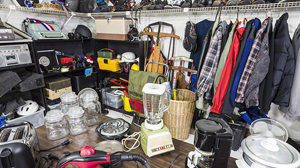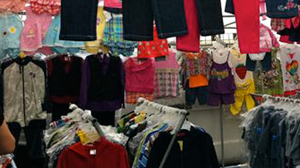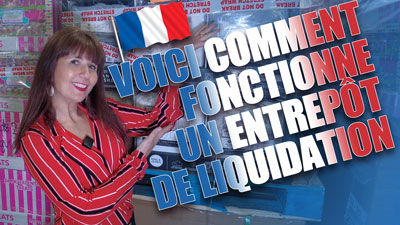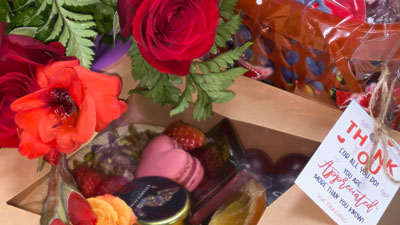If you’ve ever spoken with a representative at Via Trading about the best ways to resell liquidation products, you may have heard this as their number one recommendation: maximize your resale channels. The more resale channels are used to move products, the better the chances of selling everything and recovering the highest return on investment. Jeff and Debbie Tanner, customers of Via Trading since May 2010 have taken this to heart and have created a business based on moving a maximum amount of goods through as many resale channels as possible.

The Tanners began their resale business as a way to supplement their incomes in January of 2010. They began selling items out of their front yard in a weekly garage sale, which quickly evolved into a multi-channel business that brings them significant monthly profits. “I’ve been doing this business full time with three people for one year, and it all started from selling small things at garage sales and grew into buying full pallets and loads of merchandise that we are able to move in a couple of weekends,” says Jeff Tanner. “Today, we sell items at swap meets, farmers markets, on Craigslist and eBay,” he continues.
When asked how he came to expand his business into several retail channels, Tanner says that “[he] saw an opportunity to get more money for items that were in great condition online. Flea market and yard sale buyers are usually looking for the very best deal while online buyers are looking for a discount off the original price, but they’re generally willing to pay a little more.” This realization has allowed him to set up a business that brings in the most bang for his buck. Why sell items for less than they are worth at a rock-bottom-pricing flea market when you can get more out of it selling it in another way? This kind of creativity is what leads to long-term success in this industry.
Over the last year Jeff and Debbie have been focusing on selling both new overstock and customer return brand name items from large department stores. Their primary category of focus is housewares and table top/home decor items. While it can be easier to tailor your purchases to your intended resale channel (buy only items that you know will sell in your resale environment of choice), Jeff and Debbie take the opposite approach. “We buy the same category of item every time, and we just figure out which specific items inside each load will sell best through each channel.”
“We take the pallets home, break them down and see what we’re working with. From there we test the items, then decide where and how to sell them,” explains Debbie. Items that are out of box and potentially damaged tend to sell better at swap meets where people can see the items in person and determine whether or not they will be able to fix and use them. In-box items with higher original retail values are set aside for listing on craigslist and ebay, which requires photographing them, writing up a description and listing them online.
The condition of the items is only one factor used to determine how and where to sell the items. Another factor is size. “Large items are too big, bulky and heavy to ship (which makes them too expensive) so we sell those at yard sales. The smaller items we sell online.” While this strategy works very well in most cases, there are occasionally smaller items that don’t sell online as they had expected. Instead of sitting on those products for an extended period of time, the Tanners take those items to the flea market and clear them right out. “There’s no point waiting for an item to sell. We would rather just turn the inventory over quickly, make some money and get more items to sell. If something doesn’t sell in one way, there are high chances it will sell in another way, even if it means at a slightly lower price.”
On the topic of price, determining what price to put on the items can be tricky. Jeff takes advantage of the retail labels that come on most of the items he purchases to determine a fair selling value for them. “Most of the time I will just price the items at 50% off what the sticker price is. That way, my customer is getting a great deal and I don’t have to spend too much time researching the right price. Half off is great deal!” In this way, Jeff is able to make approximately 50% return on each investment. While no two orders generate the exact same amount of profits, overall he recuperates more than what he invested which keeps his business profitable. “It helps that we buy a lot of overstock items. Once we’re done going through them and repairing items, we only have to throw away about 2% of what we buy, which is really good in this industry.” While the percentage of throwaway items varies from load to load, the Tanners have found that purchases are profitable in the long run.
One of the hardships of selling merchandise outdoors at flea markets and farmer’s markets is unfortunately the weather. While Southern Californians have it easy, it’s not possible to sell items outside year-long in most states. “That’s why we like the online portion of our business as well,” says Jeff. “If it’s raining, we don’t depend on those flea market sales to make it. We just focus our efforts on our online sales until the weather clears up and we can go back out again.” This strategy ensures they are able to do business year-round without being at the mercy of the sunshine.
Jeff and Debbie recommend their business model to others starting out in the liquidation industry. “Be creative, keep it simple and keep the faith. It’s not always easy but it will all work out if you stick to your plan. There is a right selling place and a right price for everything – it’s just a matter of finding what works and sticking with it.”
Check out Jeff and Debbie’s collection of high end housewares and home decor on their eBay store at tannertanner16, or visit their flea market booth at the Saugus and Beaumont Swap Meets.










